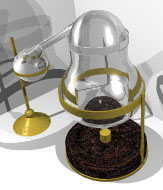From Wikipedia, the free encyclopedia/Blog Ref http://www.p2pfoundation.net/Multi-Dimensional_Science
This article is about alchemical stills. For the guitar manufacturer, see Alembic Inc. For computer graphics, see Alembic (Computer Graphics).
An alembic (from Arabic الأنبيق (al-anbīq), from Greek ἄμβυξ (ambyx), possibly from Semitic[1]) is an alchemical still consisting of two vessels connected by a tube, used for distilling chemicals. Technically, the alembic is the lid with a tube attachment (the still-head), which is placed on top of a flask, the cucurbit, containing the material to be distilled, but the word is often used to refer to the entire distillation apparatus. If the lid and flask are in one piece, it may be called a retort. The liquid in the cucurbit flask is heated or boiled; the vapour rises into the alembic hood, where it cools by contact with the walls and condenses, running down the spout into a receiving flask.A modern descendant of the alembic (used to produce distilled beverages) is the pot still.
Contents
[hide]Etymology[edit]

Alembic metalwork in the staircase at the Chemical Faculty of Gdańsk University of Technology, 1904.
The alembic symbol is Unicode U+2697 ALEMBIC (⚗).
History[edit]
The earliest appearances of alembics are to be found in the works of ancient Persian alchemists,[2] such as Jabir al-Tusi (Geber). Muhammad ibn Zakariya al-Razi, who conducted the first documented scientific studies on distillation, used alembics in his scientific work.[3] This work was extended during the Middle Ages by Muslim alchemists like Avicenna and Al-Farabi.
Ambix, cucurbit and retort of Zosimos, reproduced in Collection des anciens alchimistes grecs by Marcelin Berthelot
Large "charentais" type alembic for distilling spirits, manufactured by Chalvignac Prulho Distillation, France
Copper retort
See also[edit]
References[edit]
- Jump up ^ Forbes, Robert James (1970) A Short History of the Art of Distillation: from the beginnings up to the death of Cellier Blumenthal. Leyden: E. J. Brill ISBN 978-90-04-00617-1; p. 23
- Jump up ^ Encyclopædia Britannica 1911, Alchemy.
- Jump up ^ Forbes, Robert James (1970) A Short History of the Art of Distillation: from the beginnings up to the death of Cellier Blumenthal. Leyden: E. J. Brill ISBN 978-90-04-00617-1; pp. 20-23
External links[edit]
| Wikisource has the text of the 1911 Encyclopædia Britannica article Alembic. |







No comments:
Post a Comment